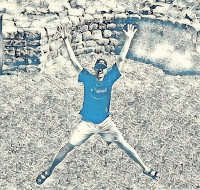When people present themselves at my clinic, they are usually looking for a specific 'fix' for what they perceive to be their specific problem.
The truth is that most issues come down to the same 2 things.
- How you move, or
- The fact that you don't move.
 The many ailments that present themselves can be viewed as cracks, stresses and strains in the structure of your body. These may present in many different places and working on them is rather like plastering over the cracks. Eventually you have to look for the root of the problem. That is usually found in the foundations. The foundation of movement - if that is strong and correct then everything will work in perfect dynamic posture.
The many ailments that present themselves can be viewed as cracks, stresses and strains in the structure of your body. These may present in many different places and working on them is rather like plastering over the cracks. Eventually you have to look for the root of the problem. That is usually found in the foundations. The foundation of movement - if that is strong and correct then everything will work in perfect dynamic posture.If, on the other hand, you have weaknesses, overused structures or movement patterns that are not suitable for the structure of your body, damage will result.
How do we learn these poor movement patterns?
We start off well enough but as soon as our first shoe is fitted our body mechanics is changed. Imagine our hands were put into mittens at 14 months old and we had to learn to cope with our many textured world through the mittens.
Imagine our hands were put into mittens at 14 months old and we had to learn to cope with our many textured world through the mittens.Then, as an adult, we trap our wrists into extension, as a shoe heel does to the ankle! Touch typing would not be so easy!
How would we have adapted to manage without all of those fingers and our wrists?
The body has had to adjust to the many difficulties that shoes present. Lack of flexibility, lack of feedback, restricted space. The result is a great deal of strain on other joints and structures.
The next lot of damage occurs when we do not get to exercise ourselves to our full potential.
 Rather than body testing mixed activities we are trained in specific sets of movement skills so we become good at a particular game. A 5 year old football champ that can't climb a tree is already in crisis!
Rather than body testing mixed activities we are trained in specific sets of movement skills so we become good at a particular game. A 5 year old football champ that can't climb a tree is already in crisis!Then there is the problem of chairs and computer terminals, cars, commuting........ the damage is endless in our modern lifestyle.
When we do try and exercise we take this broken piece of biomechanical wizardry out and we bash it around, hitting balls with sticks, chasing people or more balls in our deformed feet, pedalling, lifting or squeezing on some crafted piece of machinery. We do this in ignorance of our body's true fabulous form and function.
Thinking to ourselves, 'hey! I am exercising, it is good for me, right? I am fit, right?'
If you are in pain then no, you are not fit. Broken is not fit for purpose.
The solution is to start at the basics. Learn to move. It takes strength, flexibility, agility, power and stamina in every joint all directions and in all combinations. Choose a selection of activities that challenge every joint and every aspect of fitness.
Some basic guidelines might be.
- If your wrists can't hold your bodyweight for more than a few seconds,..don't be lifting weights over your head with them...Yet!
- If you don't have the flexibility to kneel or perform a full squat,... don't try running. Yet!
- If you can't stand and be stable on your tip toes with your weight through the pads of the big toe don't try body pump.,,,, Yet!
- If you have bunions callouses, collapsed ankles or any other deformity of the feet, the likelihood is that they are incapable of doing the job of moving you, instead you are relying on shoe to do the job of 30 plus joints. Regain full foot function. You will be surprised at how it impacts on hip knees, and even your neck
There is a lot of information out there on how to get moving safely. Educate yourself. I am currently reading Katy Bowman's book, Whole Body Barefoot. That's a good start. Or you could try Pilates or Parkour. Preferably all of the above.

